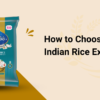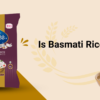No products in the cart.
Basmati rice is famous for its lovely aroma, delicate texture and unique flavour. Whether you are making a sumptuous biryani or a simple pilaf, choosing the right basmati rice is crucial to creating a great dish. With so many brands and varieties available, here is a guide to help you choose a good quality basmati rice that suits your culinary needs.
How to choose a good quality basmati rice?
- Look for the Basmati Grain:
- Length: Basmati rice grains are typically longer than regular rice. Longer grains indicate better quality because they remain separate and fluffy after cooking.
- Aroma: Good quality basmati rice has a distinct aroma, often described as nutty or popcorn-like. The stronger the fragrance, the better the rice.
2. Check the Packaging:
- Origin: Authentic basmati rice usually comes from India or Pakistan. Look for packaging that specifies its origin.
- Brands: Trusted brands with a history of producing quality basmati rice are more likely to provide a superior product. Popular brands include Tilda, Royal, and Daawat.
3. Type of Basmati Rice:
- White vs. Brown: White basmati rice is more commonly used and has a lighter texture. Brown basmati rice retains more nutrients because it is less processed and has a slightly chewy texture.
4. Grading and Certification:
- Grade: Basmati rice is often graded by its length and purity. Look for labels like ‘Pure Basmati’ or ‘Extra Long Grain’.
- Certifications: Organic certifications ensure the rice is grown without synthetic chemicals. Look for USDA Organic or similar certifications if you prefer organic products.
5. Rice Age:
- New Crop vs. Aged Rice: Newly harvested basmati rice tends to cook faster and has a softer texture. Aged basmati rice (aged for at least a year) has a firmer texture and stronger aroma.
6. Price and Value:
- Quality vs. Price: While higher price doesn’t always guarantee better quality, extremely cheap basmati rice may not meet your expectations in terms of flavor and texture. Strike a balance between quality and your budget.
7. Read Reviews and Recommendations:
- Customer Reviews: Online reviews can provide insights into the quality and taste of different brands and varieties.
- Recommendations: Seek recommendations from friends, family, or culinary experts who have experience with cooking basmati rice.
8. Cooking Characteristics:
- Water Absorption: Good basmati rice absorbs water well without becoming mushy, resulting in fluffy, separate grains after cooking.
- Cooking Time: The cooking time can vary depending on the age and type of basmati rice. Follow the instructions on the package for best results.
9. Experiment and Taste:
- Trial Packs: If you’re unsure, start with small trial packs to test different brands and types until you find the one that best suits your taste preferences and cooking style.
10. Sustainable and Ethical Sourcing:
- Fair Trade: Some brands prioritize fair trade practices and sustainable agriculture. Supporting these brands ensures ethical sourcing and supports farming communities.
Choosing good quality basmati rice enhances the flavor and texture of your dishes, making every meal memorable. Whether you prefer the classic aromatic white basmati or the nutritious brown variety, understanding these factors will help you make an informed decision when selecting your next bag of basmati rice.






Leave a reply